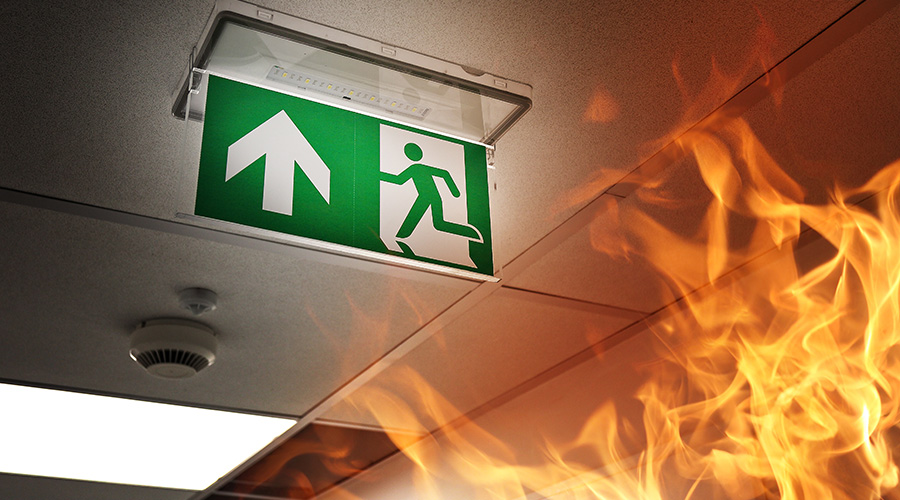Mass Notification Comes of Age
Changes in technology have made systems more robust, with alerts on different levels providing specific instructions for different situations
For many years, small towns across America have felt insulated from the wider world, convinced that “It can’t happen here.” That belief seems to be changing. Perhaps it’s the War on Terror. Perhaps it’s the increase in school shootings.
Whatever the case, and whatever the reason, Americans in all walks of life are changing their belief system — even in Ishpeming, Mich., a sleepy little mining town not far from Lake Superior. Located in Michigan’s upper peninsula, it seems a remote and unlikely place for violence to appear. Recently, however, the police in Ishpeming outfitted their patrol cars with AR-15 rifles. The shotguns with which they previously equipped officers just didn’t have the reach the officers might need, according to Chief Jim Bjorne.
He cited the recent shootings of six people by a deputy officer in Crandon, Wis., as one impetus for arming his officers with rifles. The deputy officer was killed by a SWAT team sniper. “If it can happen in a small town like Crandon, it can happen anywhere, including here. We need to be prepared for that,” says Bjorne.
Across the nation, violence in places never before suspected has spurred action — from small town police departments to college campuses.
For example, one action to take against unforeseeable emergencies is installing a mass notification system. At Kennesaw State University (KSU) in Kennesaw, Ga., campus executives were purchasing a mass notification system earlier this year when their efforts became mired in the state’s purchasing agency due to the size and scope of KSU’s request. Then the shootings on Northern Illinois University’s campus happened, and that re-ignited KSU’s request in the state agency.
While mass notification systems are not a new concept, continually assessing security needs and incorporating available technological advances are among the most important steps of any facility executive’s emergency preparedness strategy.
An Historical Need
“Notification systems go back to the origin of fire alarm systems,” says Paul Benne, security specialist at Syska Hennessy. “Ever since then, it’s been important to tell groups of people about incidents that could affect their well-being.”
Increasingly, mass notification has evolved into a much more robust technology, with alerts on multiple levels for different situations.
During the last half-century, the need and desire for mass notification systems has changed.
“Campuses have historically been safe and secure environments where academic thought is the primary focus for all,” says Bob Lang, assistant vice president for strategic safety and security at KSU. “Students, faculty and staff were concentrating on the role each played to fulfill their academic needs and support.”
But that changed in the 1960s, according to Lang. On August 1, 1966, Charles Whitman killed his wife and his mother, then took a position on the 32nd story observation deck of the administration building on the University of Texas at Austin. He killed 14 people and wounded more than 30 before Austin police shot and killed him. That event is commonly cited as the seminal justification for the formation of SWAT teams across the nation.
Lang also points to the Whitman killings as a turning point for another paradigm shift.
“Campus environments became the focus for easy access for present and former students,” he says. “As studies have now shown, most of the killers had either seen the campus psychologists or mental health personnel immediately prior to the shootings, or were seeing mental health personnel regularly.”
Since the 1960s, school shootings have become tragically more commonplace. Although most Americans can tick off a list that includes NIU, Virginia Tech and Columbine, the notion of campus violence is not confined uniquely to America. Argentina, Canada, Germany, Finland and Sweden have all had outbreaks of violence. The most deadly in history was the killing of more than 180 school-age hostages in Beslan, Russia.
With all this in mind, campuses, and the people attending or working there, must have every means to alert occupants in a timely manner to seek safety, both within and without the campus proper.
Push for Information and Speed
Mass notification is regarded by many as one piece of a stratified effort comprising an emergency plan. Used effectively, mass notification provides the early warning needed to maximize the safety of students and staff on a campus. How facility executives choose to deploy their messages depends upon many factors. Kennesaw State University took several steps and considered a number of factors when choosing their system and its functionality.
Unlike previous iterations of mass notification systems — where several types of audible sirens, bells or notes indicated what action needed to be taken — Lang says the modern role of a system should be to alert people to the specific threat. This means KSU’s system also needed to instruct people how to respond.
“Most siren systems in the past had two or three different sounds and we were expected to know the difference; short quick tones for nuclear warnings, long wailing sounds for tornadoes, etc.,” Lang says. “Technology now allows us to send an ‘alert’ tone, followed by pre-recorded messages relating to a specific situation.”
Because of this capability, facility executives can now decide whether building occupants should evacuate, shelter in place or take other action, based on the circumstance.
Benne, who routinely advises educational and arena facilities, says that facility executives need to consider response time as well as the messages they send.
He has studied “crowd crush” events — in which people are trampled to death either because of massive egress from an arena or because the crowd has pushed closer to a stage (when a band comes on stage to play, for example) — and says that the average response time for such events is 15 to 20 minutes.
“There are too many people who need to be reached before a decision can be made,” Benne says. “That’s a challenge.”
Using the arena crowd crush as an example, he says security might notify the stage manager, who notifies the show manager, who notifies others — all of which takes too long. In schools, a list of administrators might also need to be reached before a decision can be made.
Besides sirens and annuciators, using multiple mediums to reach occupants of a building is key. For KSU, the second layer is the individual notification of the emergency through a cell phone voice message, cell phone text message or e-mail.
The third level at KSU is an intercom system for each classroom and gathering area. According to Lang, this enables the same message to be heard regardless of whether the cell phone messages did or did not penetrate some buildings due to interference or non-accessibility.
The fourth and final layer at KSU is to interface with digital signage for not only the hearing impaired, but signage at the university’s main entrance.
Lang says the signage is similar to the 10-by-10-foot advertising signs in front of urban malls and in sport stadiums.
All Available Means
Lang advises using every means available to the facility executive. “The key is to use any means of communication that may be at your disposal — RF police radios, internal radio stations, fire panels with speaker capability, fax machines and pagers, if people still use them,” he says.
“An emergency is an emergency,” Benne says. “You can’t plan for everything. Even police and fire departments — when they respond to an emergency, they use the same basic tactics.”
It should be no different for facility executives, he says. Plan for how an organization wants to address an emergency, then pick the mass notification system that suits need-based criteria.
“We developed a roadmap for the strategy, then developed a needs assessment/procurement phase for the right system,” Lang says. He also cautions against vendors who tout a ‘one size fits all’ solution.
Lang says his team skipped the demonstrations and avoided manufacturer’s sales teams.
“We went directly to the people who would ultimately have to support the product. Doing so enabled us to discount many products because they didn’t meet our basic requirements.”
Lang cautions against wholesale belief in “user-friendly” systems, or systems that are too reliant on IP for lay people to understand and operate.
Lang suggests that facility executives ask themselves: What really needs to be accomplished? How much time is required to maintain that ease of operation via sending practice messages, going through the start-up menu processes, and creating “canned messages” that will save time?
And who can forget training? To overcome the challenges presented by implementing new mass notification technology on campus, Lang says they pressed vendors — even to the point of canceling contracts — to make sure the training is easy, pertinent and ongoing and to ensure that KSU’s staff could modify usage protocols to fit the campus’ changing needs.
“Training and continued usage is the key,” he says.
Security should be a consideration for every type of organization. Benne likens it to sales quotas.
“Companies don’t address sales quotas whenever there’s a problem,” he says. “That’s reactive. Instead, they’re always assessing sales goals; security should be no different. It should be under constant assessment just like so many other aspects of business and education.”
Staying the Course
Even so, sometimes best intentions can be waylaid by unforeseen roadblocks, as was the case for KSU.
“The Georgia State procurement requirements are very extensive,” Lang says. A state employee directs the procurement process whenever requests are more than $100,000.
“Many of the issues we were addressing were over that mark and we were moving as quickly as possible,” Lang says. “When the Northern Illinois incident happened, everything changed and we were able to enact an emergency clause for the effort to sole source the right system.”
However, the moment of crisis is not the time to reassess strategies.
“You need the ability to see through the hype and maintain the course,” Lang says. “Implementation of those plans is another story.”
To achieve a successful outcome during a high-stress notification situation, Lang says facility executives need to know that those doing the work on the front end of an emergency know what to do as a matter of routine.
Reinforcing Benne’s mantra about shaving response time within 60 seconds or less, Lang points out that most active shooter and workplace violence situations are over in three minutes or less. “Your people on the ground — the crisis managers for each building and location — they will be the ones to handle it before the police department or fire department even get there.”
SIMPLE ADVICE
Streamline Process to Speed Response
Paul Benne, a security specialist at Syska Hennessy, argues that seeking administrative approval during emergency situations requiring mass notification is a time-waster.
“Often, there’s a complicated authorization process which requires certain administrators to be reached,” he says. “Sometimes that is okay, sometimes not.”
Benne’s instructions to administrators at educational facilities implementing mass notification systems are simple: If a faculty member calls and says the facility needs to get locked down, it should happen immediately.
Benne says he believes lock-down (or any kind of emergency communication response) should happen within the first 60 seconds of knowing about a situation. Further messages, including specific instructions, should be sent out in another two to five minutes.
“Different situations require different reactions,” Benne says. “You never want to say, ‘There’s a chlorine gas cloud hanging over the university.’”
Instead, say that there’s a situation outside and facility personnel have requested building occupants to stay inside. Striking that balance between providing enough information to assuage occupants while providing concise instructions is delicate.
“Lack of information is just as dangerous as too much information,” Benne says.
In one school district he worked with, Benne says administrators finally ceded control of lock-down procedures to office staff.
“It’s a five-school district, and the district wanted to adjust access control based upon threats in the community,” he says.
The solution Benne devised was this: The district office is now able to press a button to elevate security in all five schools within one minute. Each individual school also has a button in their office that locks down that individual school.
“Administrators were okay with relinquishing lock-down command to office members once they saw the benefits of it,” Benne says.
|
Loren Snyder, a contributing editor for Building Operating Management, is a writer who specializes in facility issues. He was formerly the magazine’s managing editor.
Related Topics:











